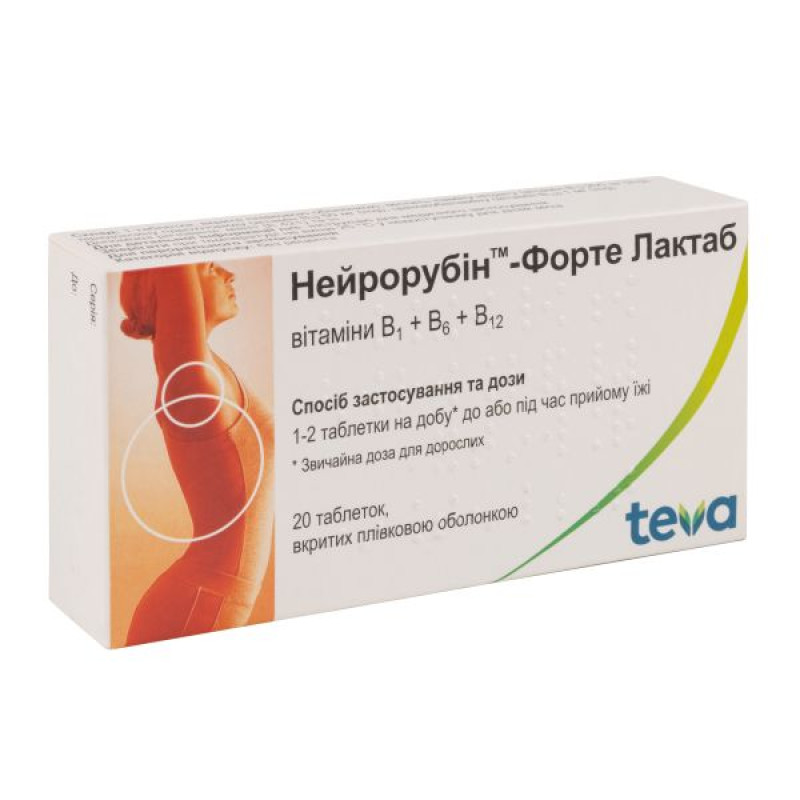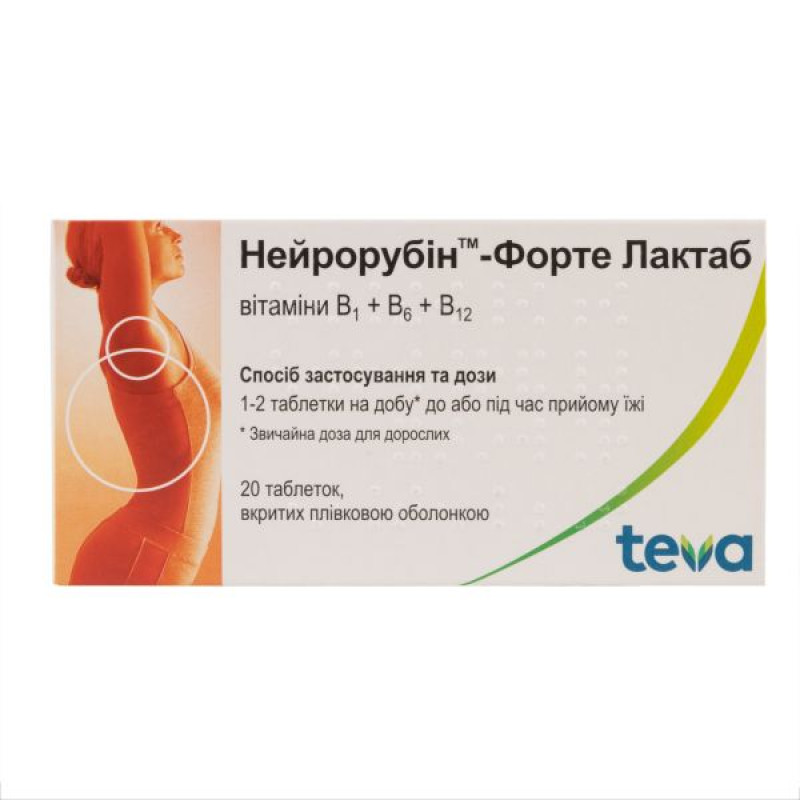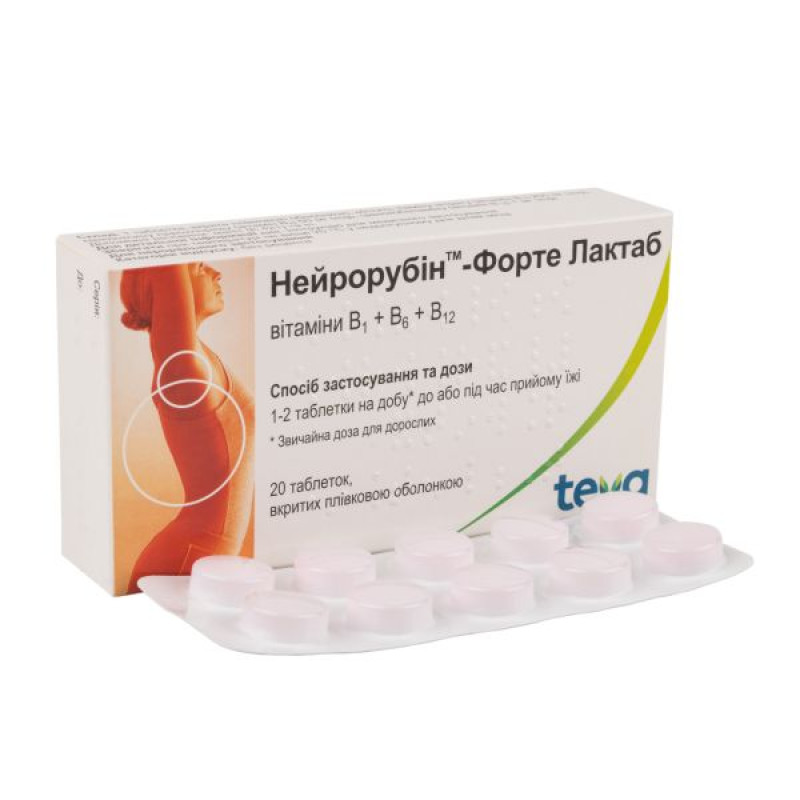Neurorubin-forte lactab film-coated tablets No. 20

Instructions Neurorubin-forte lactab film-coated tablets No. 20
Composition
active ingredients: thiamine nitrate (vitamin B1), pyridoxine hydrochloride (vitamin B6), cyanocobalamin (vitamin B12);
1 film-coated tablet contains thiamine nitrate (vitamin B1) 200 mg, pyridoxine hydrochloride (vitamin B6) 50 mg, cyanocobalamin (vitamin B12) 1 mg;
excipients: methylcellulose, mannitol (E 421), powdered cellulose, microcrystalline cellulose, pregelatinized starch, magnesium stearate, colloidal anhydrous silica, hypromellose, macrogol 6000, talc, titanium dioxide (E 171), erythrosine (E 127).
Dosage form
Film-coated tablets.
Main physicochemical properties: pink, round, biconvex tablets, film-coated, embossed with "TR" on one side.
Pharmacotherapeutic group
Vitamin B1 preparations in combination with vitamin B6 and/or vitamin B12. ATX code A11D B.
Pharmacological properties
Pharmacodynamics
Neurorubin™-Forte Lactab combines high doses of three vitamins: B1, B6 and B12, which play a major role in the normal functioning of the nervous system. Each of these vitamins is necessary for optimal metabolism in nerve cells. In addition, when used in high doses, these vitamins have an analgesic effect.
Like all other vitamins, they are essential nutrients that cannot be synthesized directly in the body.
Therapeutic administration of vitamins B1, B6 and B12 into the body replenishes the insufficient intake of vitamins with food, which ensures the presence of the necessary amount of coenzymes in the body. B vitamins are components of enzyme systems that regulate the metabolism of proteins, fats and carbohydrates. However, each of the B vitamins performs a specific biological role. Their presence in the body in a balanced amount is necessary for the normal functioning of metabolism.
The therapeutic use of these vitamins in various diseases of the nervous system is aimed, on the one hand, at compensating for the simultaneously existing deficiency (possibly due to an increase in the body's need caused directly by the disease) and, on the other hand, at stimulating natural recovery mechanisms.
Vitamins B1, B6 and B12 have very low toxicity and pose no potential risk to humans. There is currently no evidence of carcinogenic, mutagenic or teratogenic properties of these vitamins.
Pharmacokinetics
Thiamine nitrate (vitamin B1) is absorbed in the small intestine, duodenum and colon with the participation of the active transport system. After use, the active substance penetrates the intestinal mucosa, and then enters the liver via the portal vein. Some of the absorbed thiamine participates in enterohepatic recirculation. The main products of thiamine excretion are thiaminecarboxylic acid and pyramine (2,5-dimethyl-4-aminopyrimidine), as well as a relatively small amount of thiamine excreted unchanged.
Pyridoxine hydrochloride (vitamin B6) is rapidly absorbed in the intestine. In the body, pyridoxine is oxidized to pyridoxal or aminated to pyridoxamine. The condition for its functioning as a coenzyme is phosphorylation at the CH2OH group in the fifth position, i.e. the formation of pyridoxal-5-phosphate (PALP). In the blood, about 80% of PALP is bound to proteins. Pyridoxine mainly accumulates in the muscles as PALP. The main excretion product is 4-pyridoxic acid.
Cyanocobalamin (vitamin B12). In a healthy person, the absorption of cyanocobalamin is limited and depends on the concentration of "intrinsic Castle factor". Some vitamin B12 is absorbed in the free state, but the bulk is absorbed only after binding to "intrinsic Castle factor".
After absorption in the intestine, vitamin B12 binds in the blood serum to specific proteins B12-binding-beta-(transcobalamin) and B12-binding-alpha1-globulin. Vitamin B12 is stored mainly in the liver. The half-life from blood plasma is 5 days, from the liver - about a year.
Indication
Concomitant therapy of pain syndromes caused by:
acute or chronic neuritis, polyneuritis and neuralgia; toxic lesions of nervous tissue in alcoholism, diabetic polyneuropathy, drug intoxication.
Contraindication
Hypersensitivity to any component of the drug.
Vitamin B1 is contraindicated for use in allergic diseases.
Vitamin B6 is contraindicated for use in cases of gastric and duodenal ulcers in the acute stage (since increased acidity of gastric juice is possible).
Vitamin B12 is contraindicated for use in erythremia, erythrocytosis, and thromboembolism.
Interaction with other medicinal products and other types of interactions
The action of thiamine is inactivated by 5-fluorouracil, as the latter competitively inhibits the phosphorylation of thiamine to thiamine pyrophosphate.
The toxicity of isoniazid may increase.
Antacids, alcohol, and tea slow down the absorption of vitamin B1.
Concomitant use with pyridoxine antagonists (e.g. isoniazid, hydralazine, penicillamine or cycloserine) or oral contraceptives may increase the need for vitamin B6.
Pyridoxine may decrease the effectiveness of altretamine.
Concomitant use with levodopa is contraindicated, as vitamin B6 may reduce the antiparkinsonian effect of levodopa. Concomitant use with pyridoxine antagonists (e.g. isoniazid, hydralazine, penicillamine or cycloserine), oral contraceptives may increase the need for vitamin B6.
Application features
As a result of hypersensitivity to vitamins B1, B6 and B12, skin and subcutaneous tissue reactions may occur during therapy.
Pyridoxine can provoke the appearance of acne or acne-like skin rashes, or aggravate the manifestations of existing ones.
When vitamin B12 is administered, the clinical picture, as well as laboratory tests in funicular myelosis or pernicious anemia, may lose their specificity.
Drinking alcohol and black tea reduces thiamine absorption.
Consumption of beverages containing sulfites (e.g. wine) increases the degradation of thiamine.
Since the drug contains vitamin B6, the drug should be used with caution in patients with a history of peptic ulcer of the stomach and duodenum, severe renal and hepatic dysfunction.
Patients with neoplasms, except in cases accompanied by megaloblastic anemia and vitamin B12 deficiency, should not use the drug.
The drug should not be used in severe or acute forms of cardiac decompensation and angina pectoris.
Ability to influence reaction speed when driving vehicles or other mechanisms
The drug does not affect the ability to drive or operate complex mechanisms.
If dizziness occurs during treatment with the drug, you should refrain from driving vehicles and operating machinery.
Use during pregnancy or breastfeeding
The drug should only be prescribed after a careful assessment of the benefit/risk ratio, as there is insufficient data on the safety of the drug during pregnancy.
Vitamins B1, B6 and B12 are excreted in breast milk. High concentrations of vitamin B6 may inhibit milk production. Studies on the extent of secretion of vitamins into breast milk have not been conducted. A decision on whether to discontinue breast-feeding or to use the drug should be made taking into account the importance of the drug to the mother. If necessary, breast-feeding should be discontinued for this period.
Method of administration and doses
Take orally before or during meals, without chewing, with sufficient water. The usual dose for adults is 1-2 tablets per day. The course of treatment is 4 weeks. For further treatment, consult a doctor.
Children
The drug should not be prescribed to children, as there is no experience of use in pediatric practice.
Overdose
Vitamin B1: has a wide therapeutic range. Very high doses (more than 10 g) exhibit a curare-like effect, inhibiting the conduction of nerve impulses.
Vitamin B6: has very low toxicity.
Neuropathies have been observed with long-term use (more than 6–12 months) of daily doses exceeding 50 mg of vitamin B6, as well as with short-term use (more than 2 months) of more than 1 g of vitamin B6 per day.
Neuropathies with ataxia and sensory disturbances, cerebral convulsions with EEG changes, and in isolated cases hypochromic anemia and seborrheic dermatitis have been described following administration.
>2 g per day. In this regard, constant monitoring is recommended during long-term use.
Vitamin B12: After parenteral administration (in rare cases, after oral administration) of the drug in doses higher than recommended, allergic reactions, eczematous skin disorders, and benign acne have been observed.
With prolonged use in high doses, liver enzyme activity disorders, pain in the heart area, and hypercoagulation are possible.
Therapy for oral intoxication: removal of the toxic substance (induce vomiting, wash the stomach), measures to reduce absorption (use of activated charcoal).
Adverse reactions
Immune system disorders: hypersensitivity reactions, anaphylactic shock, anaphylaxis. Allergic reactions occur quite rarely.
On the part of the endocrine system: prolactin secretion is inhibited.
Nervous system: feeling of restlessness; long-term use (over 6-12 months) of vitamin B6 in doses >50 mg daily may lead to peripheral sensory neuropathy, nervous excitement, malaise, dizziness, headache.
Cardiovascular system: tachycardia, collapse.
Respiratory, thoracic and mediastinal disorders: cyanosis, pulmonary edema, respiratory distress.
Gastrointestinal disorders: gastrointestinal disorders, including nausea, vomiting, diarrhea, abdominal pain, increased acidity of gastric juice, bleeding.
Skin and subcutaneous tissue disorders: rash, skin reactions including pruritus, urticaria, acne vulgaris, acneiform eruption, erythema multiforme.
Renal and urinary disorders: chromaturia.
Other disorders: increased sweating, feeling of weakness, dizziness, malaise, feeling of tightness in the throat.
Expiration date
2 years.
Storage conditions
Store at a temperature not exceeding 25 °C out of the reach of children.
Packaging
10 film-coated tablets in a blister, 2 blisters in a cardboard box.
Vacation category
Without a prescription.
Producer
Acino Pharma AG.
Location of the manufacturer and its business address
Dornacherstrasse 114, 4147 Esch, Switzerland.
Birsweg 2, 4253 Lisberg, Switzerland.
There are no reviews for this product.
There are no reviews for this product, be the first to leave your review.
No questions about this product, be the first and ask your question.






